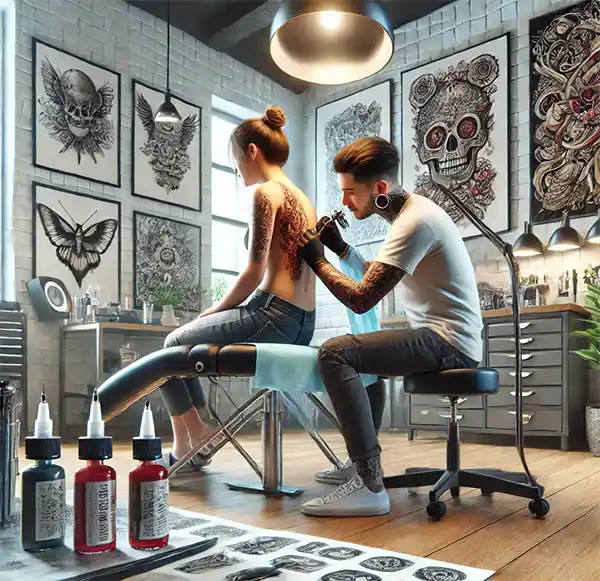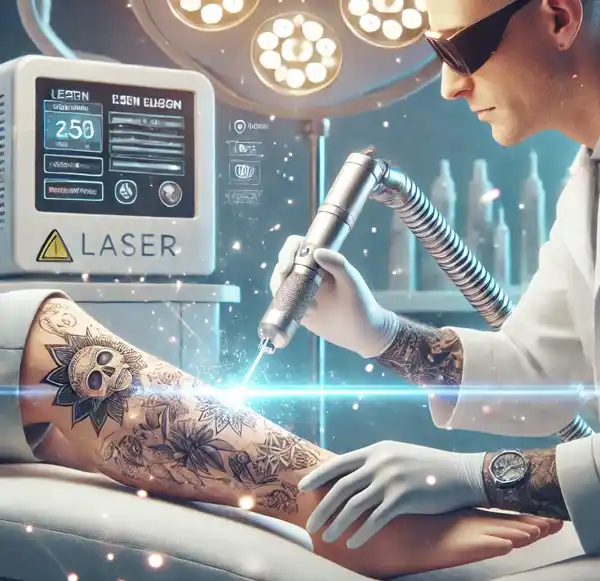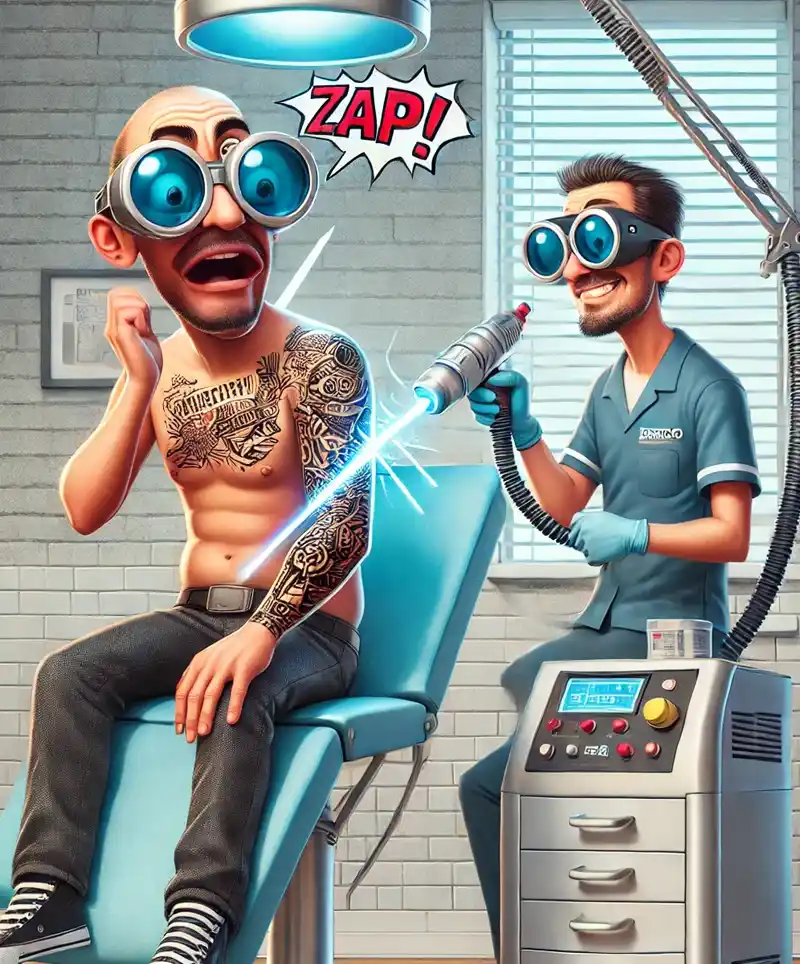Goodbye Ink, Hello Fresh Start
August 14th is National Tattoo Removal Day, a day dedicated to those who’ve realized that what seemed like a great idea at 2 a.m. after a few too many drinks maybe wasn’t the best long-term decision. Whether it's an ex’s name, a tribal band that screamed "cool" in the 90s, or a Chinese character that supposedly means "strength" but actually means "noodles," this day is all about giving people the chance to say goodbye to their tattooed regrets and hello to a fresh start.
The Rise of Tattoo Culture—and Its Regrets
Tattoos have long been a form of personal expression, with roots tracing back thousands of years. Ancient cultures like the Egyptians, Polynesians, and Celts used tattoos for various purposes, including marking social status, religious beliefs, and rites of passage. However, the modern tattoo culture as we know it began to take shape in the late 19th and early 20th centuries, particularly with the advent of electric tattoo machines, which made the process faster and more accessible.
 In the post-World War II era, tattoos in the West were often associated with sailors, bikers, and countercultural movements. These tattoos were symbols of rebellion, personal freedom, and identity, often marking life experiences, affiliations, or defiance against societal norms. As time passed, tattoos became more mainstream, moving from the fringes of society into the heart of pop culture.
In the post-World War II era, tattoos in the West were often associated with sailors, bikers, and countercultural movements. These tattoos were symbols of rebellion, personal freedom, and identity, often marking life experiences, affiliations, or defiance against societal norms. As time passed, tattoos became more mainstream, moving from the fringes of society into the heart of pop culture.
The 1990s and early 2000s saw an explosion in tattoo popularity, driven by a mix of celebrity influence, reality TV shows like "Miami Ink," and the growing perception of tattoos as an art form rather than just body modification. Suddenly, everyone from college students to suburban moms was getting inked, with tattoos becoming a symbol of individuality and self-expression.
However, this surge in popularity also led to a rise in tattoo regret. With more people getting tattoos on impulse—perhaps influenced by a fleeting trend, a memorable trip to Vegas, or the persuasive charms of a new romantic partner—the number of people seeking tattoo removal increased accordingly. The National Library of Medicine reports that up to 25% of people with tattoos express regret about at least one of their tattoos.
This regret often stems from a few common sources. For one, as people age, their tastes and life circumstances change. What seemed like a cool or meaningful tattoo in one's 20s might feel outdated or irrelevant by the time they reach their 40s. Similarly, tattoos that were once considered symbols of love or loyalty can become painful reminders of relationships that have since ended.
Moreover, the increasing accessibility of tattooing—along with the rise of inexperienced tattoo artists—has sometimes led to poorly executed tattoos. Misspelled words, crooked designs, and faded ink can all contribute to regret, especially when these tattoos are prominently displayed.
Additionally, the sheer volume of tattoo parlors and artists means that not all tattoos are created equal. Some people end up with tattoos that are less than stellar in quality, leading to dissatisfaction as the novelty wears off. What might have started as a vibrant and detailed piece can fade, blur, or lose its appeal over time, leaving the wearer wishing they had opted for something different.
Cultural shifts also play a role in tattoo regret. A design or symbol that was once popular or culturally significant can lose its meaning or even take on negative connotations as societal values evolve. This has led to an increase in tattoo removals as people seek to disassociate from symbols that no longer align with their beliefs or identity.
In recent years, the professional world has also influenced tattoo regret. While many industries have become more accepting of visible tattoos, there are still sectors where body art is frowned upon or outright banned. As people advance in their careers, they may find that the tattoos they once proudly displayed are now seen as a hindrance to professional growth, prompting them to seek removal.
In essence, while tattoos are a powerful form of self-expression, they also carry the risk of becoming permanent reminders of temporary feelings, trends, or relationships. National Tattoo Removal Day shines a light on the flip side of the tattoo culture coin, offering a path to recovery for those who realize that their inked decisions may not stand the test of time.
 How It Works
How It Works
So, what do you do when you’ve outgrown your ink? Enter the tattoo removal process. Tattoo removal has come a long way from the days when it involved painful procedures like dermabrasion (literally sanding the tattoo off) or surgical excision (cutting the tattoo out). Today, the most common method is laser tattoo removal, which is both more effective and less invasive—though, let’s be honest, still not exactly a walk in the park.
Laser tattoo removal works by targeting the ink with pulses of high-intensity light that break the ink particles down into smaller fragments, which are then absorbed and removed by the body’s immune system. Different colors of ink absorb different wavelengths of light, so the process might require multiple types of lasers to remove a multi-colored tattoo. And yes, it usually takes several sessions to fully remove a tattoo, so prepare to become best friends with your laser technician.
Of course, like anything in life, the process of tattoo removal comes with its own set of humorous (and sometimes painful) stories. There’s the irony of sitting through a few hours of needlework to get a tattoo, only to spend months trying to remove it. Or the moment you realize that your "No Regrets" tattoo is literally becoming a regret—classic.
And let’s not forget the awkward conversations that can ensue. Explaining to your laser technician why you need your ex’s name removed for the fourth time or trying to justify that impulsive SpongeBob tattoo to your grandkids can be, well, character-building.
Life After Tattoo Removal
Once the ink is gone, many people report feeling a sense of relief, as if a weight has been lifted off their shoulders—or in this case, their skin. The decision to remove a tattoo often symbolizes personal growth, a change in identity, or simply a fresh start. It’s like Marie Kondo-ing your body—if the tattoo doesn’t spark joy anymore, it’s time for it to go.
However, it’s worth noting that tattoo removal isn’t always perfect. Some tattoos fade but don’t disappear entirely, leaving a ghostly outline or a shadow of the past. Still, many people find that even a faded tattoo is preferable to one that no longer fits their life or style.
National Tattoo Removal Day
National Tattoo Removal Day is a great opportunity to reflect on the choices we’ve made—good, bad, and inked—and to consider what it means to truly move on. Whether you’re booking your first removal session, finishing up your last, or just laughing at the memory of that time you almost got a tattoo, it’s a day to celebrate the freedom of change.
So, raise a glass (or a laser) to National Tattoo Removal Day! It’s proof that no mistake is truly permanent, at least not when you have the right tools to correct it. And if nothing else, it’s a great reminder to think twice before getting that next tattoo.
In the end, tattoos are just one more way we express ourselves—and sometimes that expression changes. National Tattoo Removal Day isn’t about judging the past but embracing the future, one laser pulse at a time. Because while ink might be forever, regret doesn’t have to be.
Please Share our Content






 In the post-World War II era, tattoos in the West were often associated with sailors, bikers, and countercultural movements. These tattoos were symbols of rebellion, personal freedom, and identity, often marking life experiences, affiliations, or defiance against societal norms. As time passed, tattoos became more mainstream, moving from the fringes of society into the heart of pop culture.
In the post-World War II era, tattoos in the West were often associated with sailors, bikers, and countercultural movements. These tattoos were symbols of rebellion, personal freedom, and identity, often marking life experiences, affiliations, or defiance against societal norms. As time passed, tattoos became more mainstream, moving from the fringes of society into the heart of pop culture. How It Works
How It Works








 "Sláinte!" is a traditional Irish expression used as a toast, equivalent to "Cheers!" in English.
"Sláinte!" is a traditional Irish expression used as a toast, equivalent to "Cheers!" in English.